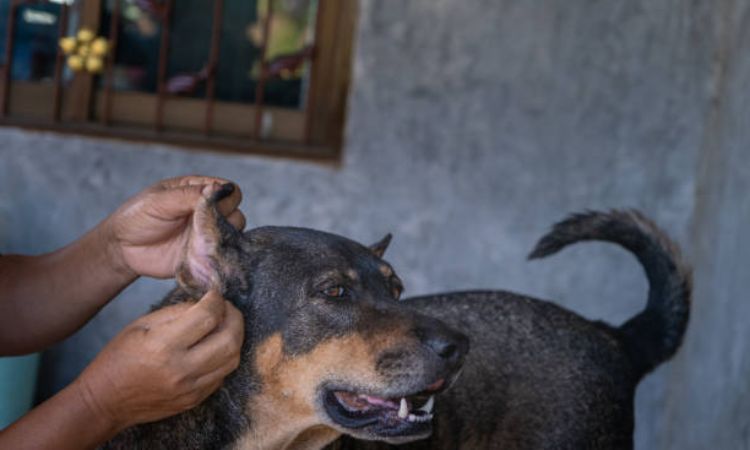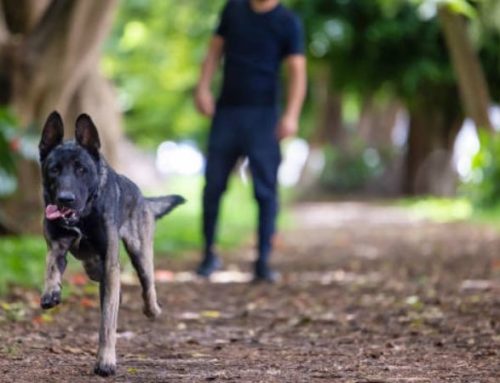Your dog’s ears aren’t just for listening they’re a vital part of how your pup communicates, expresses emotions, and stays alert to the world around them. When one ear suddenly droops or won’t stand up like it used to, it might be more than just a harmless change in appearance. The underlying cause could be damage to the ear cartilage a condition many pet owners overlook until it becomes more serious.
In this guide, Nexus-pets breaks down everything you need to know about broken ear cartilage in dogs, from the early warning signs to effective treatment options.

Causes of Broken Ear Cartilage in Dogs
Broken ear cartilage in dogs can result from a variety of factors, ranging from physical injury to underlying health issues. Recognizing these causes is crucial for timely intervention and preventing further damage to your dog’s ears.
- Trauma from Play, Accidents, or Injury: Dogs can easily injure their ear cartilage through rough play, falls, or accidental pulls and bends. Puppies are especially at risk as they explore and play, which can lead to accidental damage.
- Chronic Ear Infections: Ongoing or untreated ear infections cause inflammation and weaken the cartilage over time. Persistent scratching and head shaking worsen the damage, increasing the chance of cartilage breakage.
- Ear Parasites (Mites and Ticks): Parasites that inhabit the ear canal cause intense itching and discomfort. This often leads dogs to scratch and shake their heads vigorously, which can injure the ear cartilage.
- Genetic Factors: Certain breeds are more prone to cartilage damage due to their ear type. Dogs with floppy ears tend to have softer, more flexible cartilage, while breeds with erect ears usually have firmer cartilage less susceptible to injury.
Besides Allergies, irritants, or other conditions that cause frequent scratching or shaking can gradually weaken and damage the ear cartilage.
Symptoms and Signs of Broken Ear Cartilage
Broken ear cartilage in dogs manifests through several noticeable symptoms that affect the appearance and behavior of the affected ear. One of the most obvious signs is a droopy or floppy ear that fails to hold its normal shape. Instead of standing erect or resting naturally, the ear may appear misshapen or limp, often hanging awkwardly.
In addition to the change in ear position, the ear flap may show visible swelling or thickening due to inflammation or injury. This area might also feel warm to the touch and display redness or bruising, which are signs of localized trauma or infection.
Dogs with damaged ear cartilage often experience pain or discomfort when the ear is handled, and this sensitivity may cause them to react negatively if you try to touch or examine the ear.
Behavioral signs include frequent shaking of the head or persistent scratching at the affected ear as the dog tries to relieve irritation or pain. These repetitive actions can further exacerbate the injury or delay healing.
Overall, a combination of altered ear position, physical changes to the ear flap, and behavioral symptoms should prompt a veterinary evaluation to assess the severity of the cartilage damage and determine appropriate treatment.

Complications Associated with Broken Ear Cartilage
Broken ear cartilage in dogs can lead to several serious complications if not properly managed. One common issue is the development of an aural hematoma, which occurs when blood collects between the cartilage and the skin of the ear flap. This condition causes painful swelling and can further distort the ear’s shape, often requiring veterinary intervention to drain the accumulated blood and promote healing.
In some cases, untreated or severe cartilage damage results in permanent ear deformities. The ear may become chronically misshapen, floppy, or scarred, affecting both the appearance and function of the ear. Such deformities can sometimes be irreversible, impacting the dog’s ability to express emotions through ear movements or even slightly diminishing hearing capability.
Additionally, a broken ear cartilage that is left untreated increases the risk of secondary infections. Open wounds or persistent irritation from scratching and head shaking can introduce bacteria, leading to chronic pain and further inflammation. This ongoing discomfort not only affects the dog’s quality of life but also complicates treatment and recovery.
Treatment Options for Broken Ear Cartilage in Dogs
Non-Surgical Treatments for Broken Ear Cartilage
For mild cases of broken ear cartilage, non-surgical treatments are often recommended initially. These include providing your dog with ample rest to prevent further injury and allowing the ear time to heal naturally. Anti-inflammatory medications can be prescribed to help reduce swelling and relieve pain.
Additionally, protective bandaging or taping may be applied to support the ear and keep it in the correct position, minimizing further trauma and encouraging proper healing.
Surgical Interventions: Drainage and Cartilage Repair
In more severe or persistent cases, surgery becomes necessary to address the damage effectively. One common surgical procedure is the drainage of an aural hematoma, which is the accumulation of blood between the ear’s cartilage and skin. This procedure alleviates pressure and discomfort while preventing permanent deformity.
Surgeons may also repair torn or displaced cartilage by reattaching it with sutures, restoring the ear’s structure. The surgery aims to maintain as much mobility as possible while correcting the ear’s shape for both functional and cosmetic improvement.
Addressing Underlying Causes
It’s vital to treat any underlying conditions contributing to the cartilage damage. Chronic ear infections or infestations by parasites such as ear mites cause inflammation and intense itching, which often leads to scratching and worsening of the injury.
Proper diagnosis and targeted treatment—like antibiotics, antifungal agents, or parasite control—help eliminate these root causes and prevent further damage to the ear cartilage.
Post-Treatment Care and Monitoring
After treatment, careful post-operative care is essential to ensure successful healing. This includes keeping the ear clean and dry, administering prescribed medications, and monitoring for any signs of infection or swelling.
Regular follow-ups with your veterinarian are important to track recovery progress and quickly address any complications. Proper aftercare helps restore your dog’s ear health and comfort, reducing the risk of recurrence and promoting long-term well-being.

When to See a Vet?
Knowing when to seek veterinary care for your dog’s ear issues is crucial to prevent complications and ensure effective treatment. Immediate attention is warranted if your dog shows signs of severe pain, swelling, or visible injury to the ear flap.
If you notice persistent head shaking, intense scratching, or a foul odor coming from the ears, these could indicate a serious infection or underlying problem that needs prompt evaluation. Other warning signs include bleeding, discharge of pus or blood, or if the ear appears droopy or misshapen.
Early veterinary intervention can help diagnose the root cause, provide pain relief, and prevent lasting damage to the ear cartilage and surrounding tissues.
Broken ear cartilage can be a painful and concerning issue for dog owners, but recognizing the symptoms early and seeking prompt veterinary care are crucial for the best possible outcome. While accidents can happen, many cases are preventable through careful supervision, managing ear health to prevent excessive scratching, and creating a safe environment. By staying vigilant and proactive, you can help ensure your furry friend’s ears remain healthy and happy.






